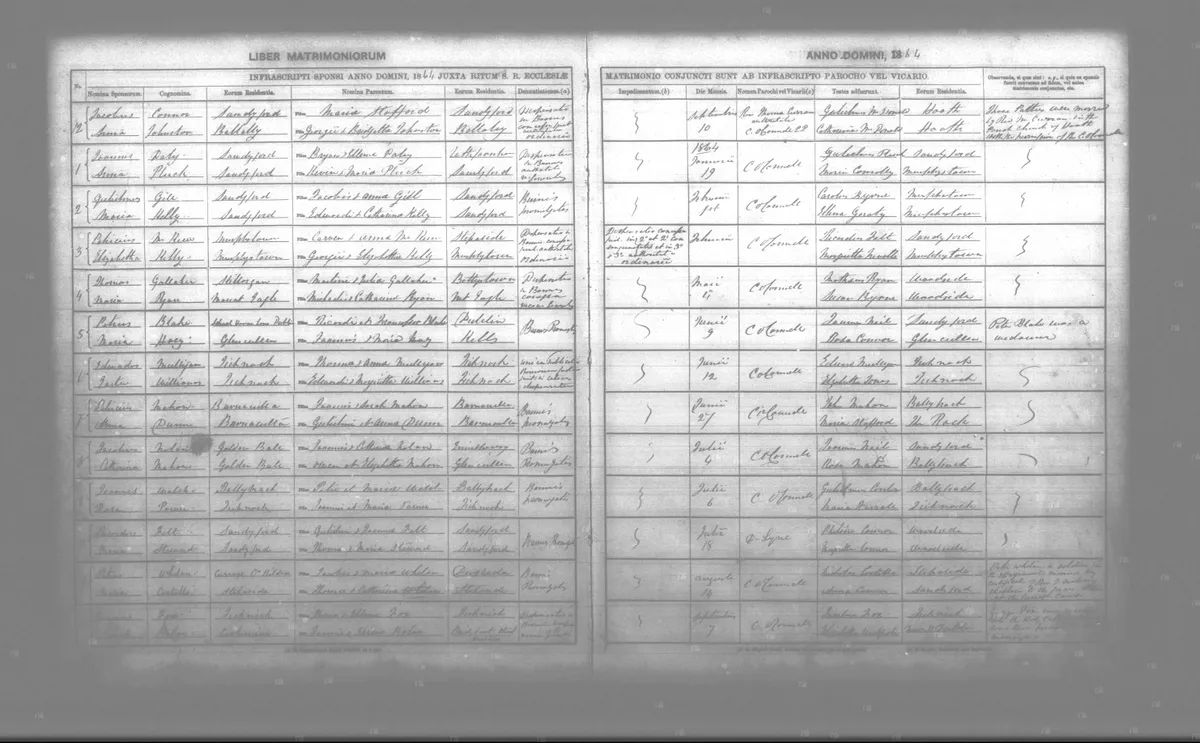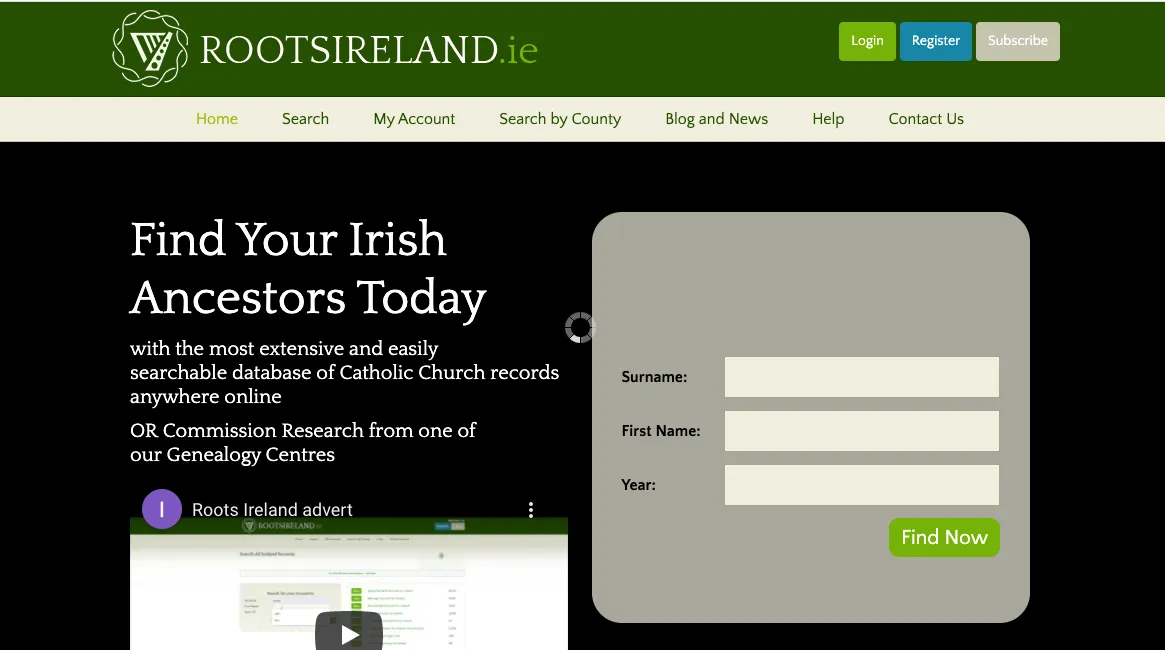Despite the Dissolution of the monasteries by Henry VIII, the 17th century confiscation of land from Catholics and the enforcement of the Penal Laws, which limited the rights of Catholics (and Presbyterians) to own property and practise their faith, the population of
18th and 19th century Ireland remained largely Roman Catholic. The majority were small farmers and labourers, although there was also a small but wealthier Catholic merchant and land-owning class.
Civil birth, death and marriage registrations for Catholics in Ireland only commenced in 1864. Although compulsory, not all births, deaths and marriages were registered with the civil authorities. In the absence of civil records, Catholic parish registers can be used for birth and marriage information.
Every part of Ireland, including Northern Ireland, falls within a Catholic parish. It is important to bear in mind that Catholic parishes differ in boundaries and often in name from civil parishes. A census return or entry in Griffith’s Valuation, a land survey completed in 1864, will identify your ancestor’s civil parish, but you must translate this into the corresponding Roman Catholic parish or parishes before you start looking for surviving registers. You can find maps and lists of civil parishes and corresponding Catholic parishes, as well as what records survive for each parish and where they are located, using the place-name search at the website Irish Ancestors.
Survival dates for Catholic parish registers vary from parish to parish. There are registers for parishes in the cities of Dublin, Limerick and Cork that commence in the 1740s, although there can be gaps in the registers. Records for parishes in north-western counties like Mayo and Donegal don’t commence, in some cases, until the 1850s or 1860s.
Before embarking on what could be a futile search, try to determine the extent of the records that survive for the area in which your forebear originated. One of the many pitfalls of searching big databases of Irish Catholic parish registers is settling on a baptism with a matching name, but failing to realise that the records for the parish your ancestor came from no longer survive and the matching record is for someone else’s family, in an entirely different parish.
Most of the surviving records from the 18th and 19th centuries are baptismal and marriage registers – very few parishes kept burial registers. The registers were handwritten, usually in Latin. Fortunately, the entries should be easy to decipher without a Latin dictionary. Baptismal entries usually start with the name of the child, the parents, including the maiden name of the mother, followed by the sponsors (godparents). In some cases the address of the family is recorded in the right-hand margin. The month and the first names are written in Latin, but are generally easy to translate and the surname is the same in English and Latin. However, the parish priest may well have used variant spellings of surnames. You can find help with Latin translations on the FamilySearch wiki.

Catholic marriage registers are quite sparse and generally only record the names of the bride and groom and the witnesses. When an address is recorded in the marriage register it is often unclear to whom the address pertains. Marriages usually took place in the parish of the bride. A church marriage record for your ancestor could lead you to a baptismal record for the bride in the same parish, if the registers survive. The groom, however, may have come from elsewhere.
From the 1860s some parishes started to use pro-forma marriage registers, which usually recorded both parents of the bride and groom, their address and if they were deceased. This practice slowly spread across the country, and was generally standard by the end of the 19th century. If you obtain a civil marriage certificate for your ancestor in Ireland but cannot locate their birth using just their father’s name, the church marriage record may reveal the name of their mother and their parents’ address.
Finding Irish Catholic records online

Catholic parish registers have always been in the custody of the parish, although visiting the parish to access the registers is not recommended. Sometimes stored in cupboards, attics or even under the bed in the parochial house, the registers are and were in constant danger of being damaged or even destroyed. Registers were also misplaced, lost or removed from the parish.
In order to preserve a resource that documented the Roman Catholic population of Ireland from the mid-18th century, Dr Edward MacLysaght, chief herald of Ireland, approached the Bishop of Limerick offering the National Library of Ireland’s (NLI’s) services to help preserve these records. The Catholic hierarchy agreed to his proposal, and from the early 1950s almost the entire surviving collection of Catholic parish registers were microfilmed by the NLI. The agreed cut-off date for microfilming was 1880, 16 years after the start of civil registration in Ireland.
These microfilm copies of Roman Catholic parish registers have since been digitised and are freely available online at the website Catholic Parish Registers at the NLI.
This collection of images has been indexed by both Findmypast and Ancestry in a joint project. However, since these registers were microfilmed, more have come to light, such as an early register for the parish of Blessington, which was found in a secondhand bookshop in Dublin and returned to the parish. This register, like many others that have been found since the 1950s, is missing from the NLI, Findmypast and Ancestry collections, but has been indexed by the Wicklow Heritage Centre and is on RootsIreland.

The RootsIreland collection originated from databases created by heritage centres in each Irish county in the 1980s, who accessed the records that were in local custody, but is incomplete for counties Cork, Wexford, Monaghan, Clare, Dublin and Kerry. However, it does contain registers missing from the NLI collection. On the website, you can only view a transcription of the record which, in some cases, links to the NLI images.
Transcripts for counties Kerry, Dublin and parts of Cork are freely available online at the government website Irish Genealogy and include some, but not all, copies of the original registers.
Although there are clearly a number of websites where you can look for your Irish ancestors in Catholic parish registers, it should be noted that the quality of the transcripts in each online index varies, and there are significant errors and omissions in all collections.
Ancestry and Findmypast joined forces to transcribe the NLI images, but the quality of transcription is poor, with many surnames and first names incorrectly captured. The quality of the transcription on RootsIreland also varies from county to county and is certainly missing entries, but the search engine available on the website is a bit more dynamic.
A genealogist will always go to the primary source. If you are not confident that your search of the indexed records, irrespective of the website, has been successful, then your best option is to manually search the images for your ancestor’s parish on the NLI’s website, a method that will sometimes turn up entries that are missing from the other collections.







